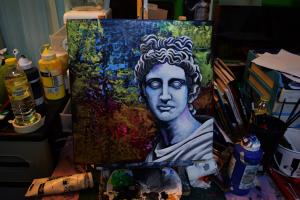Looking for design inspiration? Browse our curated collections!
February 4th, 2016 - 06:04 AM

The ancient Greek religion and mythology is as deep as any eastern philosophy, it contains pretty much everything that is in Hinduism, Buddhism and the Tao Te Ching. The language is mysterious and the style of preserving the sacred teachings and imparting them to others was very unique and special.
Apollo is one of the 12 most important Olympian Gods of the Greek religion. These gods function on many levels and represent many different things. They are at once real energetic forces of deity and at the same time embodiment's of laws of nature and Sacred truths.
Apollo is the sun, the literal sun and the sacred sun. Outwardly he is the actual sun in the sky and rules over the celestial realm, embodying the sacred light that brings all manifestation into being. Apollo is the sign of Leo in the Zodiac, again representing the ruling sun. He is the creative life giving aspect of Zeus. He is also the light within man, the divine spark, the sun within man, the creative force that drives us to make things and strive for new information and skills. The joy and enthusiasm one feels in ones heart whilst engaged in some creative project. Apollo is often depicted with the 9 Muses.
I was puzzled for a while to see the deeper meaning behind the muses. Why should the sun be divided into nine? Why should Apollo be followed by nine muses? It seemed to me to be creative in nature. I think maybe the muses have something to do with octaves. In a lot of Greek sculptures they are seen grouped into three. Maybe three represent a full Octave. Therefore the nine represent the progression of three full octaves
Maybe what we have in the nine muses is a symbolic representation of two important laws of nature. The law of three forces:- active, passive and neutral, and the law of octaves. All creative processes are directly influenced by the three forces, these forces manifest everywhere. The law of octaves tells us that all things created by the three forces are musically ordered.
The three muses representing the passive octave might be Urania the muse of astronomy, Clio the muse of history and Melpomene who was the muse of tragedy. The three muses representing the neutral octave might be Terpsichore the muse of dance, Euterpe who was the muse of music and Thalia the muse of comedy. The three muses representing the active and higher octave might be Polyhymnia the muse of sacred poetry, Erato who was the muse of love poetry and Calliope who was the muse of epic poetry.
Another aspect of the muses that occurred to me was the nature of each muse. Each muse represents something to do with the arts. I couldnít figure this out for a while. I mean why isnít there a muse for painting, drawing or sculpture? But then I realized the muses donít represent the different art forms. They represent all of the possible subject matters that an artist can work with. All paintings, poems, stories, or sculptures will fall into one or more of the categories of subject that the 9 represent.
So Apollo, amongst other things, represents the creative force within man. The nine muses explain how this creative force works and the different areas within which it functions.
Comments
There are no comments on this blog. Click here to post the first comment.